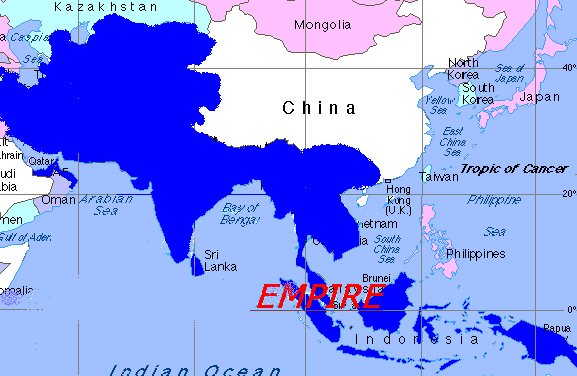 |
| Empire of Ashoka |

|
| Blue area signifies the empire |
Samrat Ashoka
T he great Indian emperor, Ashoka, was born in 265 B.C. He was the grandson of Changragupta Maurya and he ruled over an empire that covered two-thirds of the Indian continent. He was the most famous of the Mauryan kings and was one of the greatest rulers of India.
The capital of the empire was in the city of Pataliputra (modern day Patna) , where Buddha had lived.
Emperor Ashoka was very courageous and a good administrator. Though he was the younger son of the king he was given the throne after the kings death because he was loved and respected by his subjects and by his ministers. In 268 B.C., Ashoka was crowned the king of Magadha.
8 Years after being crowned the king, Ashoka's Empire spread to present Indonesia, Srilanka, India, Pakistan, Afghanistan, Iran, Iraq, Burma, Thailand, Bhutan and others. He did many reforms, one of such reform or idea became the base line of present caste system. What was the reform or idea? Emperor Ashoka tried to introduce a new rule that any one can do yagna in temples, prior to this only Brahmins were allowed to do yagnas and rest were allowed to visit temples including Shudras. Brahmins took it as attck on their livelihood and agitated but Ashoka declined their agitation. During Ashoka's reign, the Mauryan empire reached zenith, the only Kingdom that was not under his empire in India was his Beloved's Kingdom Kalinga. King Ashoka came to knew that his Beloved was already dead under the conspiracy of Kalinga's Minister so viewing that Ashoka launched a massive opertaion to destroy Kalinga. Likewise he won the Battle but to his amuse he found his Beloved among the dead soldiers in Kalinga War. He was shattered with that experience.
His experience changed him and he swore that he would never wage war again. He took-up Buddhism, and he vowed to practice only virtuous actions in the future. After instructions by members of the Buddhist community, Ashoka began to resemble the ideal leader, promoting prosperity and peace within society. He religiously followed the principles of Buddhism - that of truth, charity, kindness, purity and goodness.
|
Ashoka also asked his followers to take the path of virtuous action. He believed in non-violence and banned the sacrifice of animals. Besides this he opened clinics for birds and animals too. His good works earned him the name of Devanamapriya Priyadarshi.
He also propagated Buddhism by engraving it's principles on pillars throughout his kingdom. In way to spread Budhism a sect of Sanatan he forgot the real Vedic Culture and Brahmins went free to make new rules which led to modern caste system. The Ashoka pillars, as they are now called, were over 40 feet high and extremely heavy. He also attempted to spread this religion to Syria, Egypt and Macedonia, and sent his son Mahendra and daughter Sangamitra to Sri Lanka for this purpose. |
|
|
|
Ashoka died in 232 BC and is amongst the greatest rulers in the history of the Indian Subcontinent and he is respected for being the 'Ideal' ruler but still his negligence towards Vedic Culture were the reasons of Caste System. |
An Advanced History of Asia and S. Europe
by RC Majumdar, HC Raychaudhri, Golnar Mehran & Dr. Abdul-Moti Bayoumi
|



